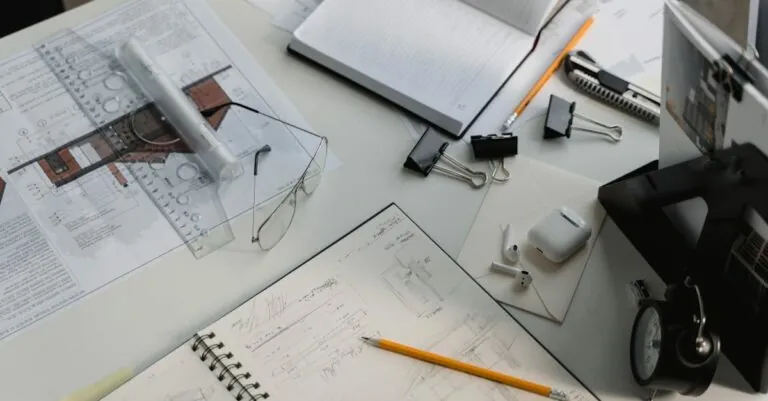Table of Contents
ToggleIn the world of storytelling, the setting is like that secret sauce that makes everything taste better. It’s not just a backdrop; it’s the stage where characters come to life and plots twist and turn. Yet, many overlook the magic that a well-crafted period setting can bring to a narrative. Whether it’s the roaring twenties or a dystopian future, understanding the nuances of time and place can elevate a story from good to unforgettable.
Imagine trying to enjoy a fine wine while sitting on a rickety old chair in a dimly lit room—just doesn’t feel right, does it? Period setting analysis dives deep into how time influences mood, character behavior, and even plot development. Buckle up as we explore why nailing the right period setting is essential for any writer looking to leave a lasting impression.
Overview of Period Setting Analysis
Period setting analysis examines the historical or futuristic backdrop of a narrative. Writers use this analysis to create a compelling context that shapes characters and plots. An accurate time period influences character behavior, mood, and thematic development.
Various elements contribute to effective period settings. Authentic details such as fashion styles, technology, and social norms ground narratives in reality. Additionally, cultural practices reflect the era’s values, enhancing reader immersion.
Notably, different time periods evoke distinct emotional responses. A Victorian setting may invoke a sense of rigidity, while a futuristic world might introduce themes of uncertainty. By analyzing these nuances, authors can effectively manipulate readers’ perceptions and emotions.
Authors adept in period setting analysis understand the importance of historical accuracy. Accurate depictions build credibility and invite readers to engage deeply with the story. Moreover, blending historical facts with creative storytelling can lead to captivating narratives rich with authenticity.
Tools for period setting analysis include research, literary texts, and visual arts. Writers often refer to historical documents, books, and art to gain insights. These resources help illuminate details that enhance authenticity within narratives.
Ultimately, period setting analysis provides writers with the means to craft immersive stories. It highlights the significance of time in storytelling, contributing to character depth and plot dynamics. Without a well-thought-out period setting, narratives may lack the resonance needed to engage audiences fully.
Importance of Period Setting Analysis

Period setting analysis plays a vital role in enriching storytelling. It allows writers to create an authentic atmosphere that resonates with readers.
Applications in Various Fields
Authors enhance narratives across genres through period setting analysis. Filmmakers use this analysis to develop accurate historical contexts for movies, ensuring audiences relate to the characters and storylines. Educators leverage period settings in literature to teach students about different eras, connecting historical events to modern issues. Game developers incorporate detailed historical elements to immerse players in different time periods, enhancing engagement and realism.
Benefits of Accurate Period Setting
Accurate period setting fosters credibility within narratives. Readers engage more deeply when they recognize authentic details like fashion, technology, and social norms. Such accuracy allows readers to lose themselves in the story, enhancing emotional investment. It creates a platform for exploring complex themes, reflecting societal changes and challenges. Writers blend facts with creativity to craft richer narratives, resulting in stories that are both entertaining and informative.
Methodologies Used in Period Setting Analysis
Understanding the methodologies in period setting analysis aids writers in crafting authentic narratives. Two primary approaches exist: quantitative and qualitative.
Quantitative Approaches
Quantitative approaches utilize numerical data to analyze period settings. Writers can evaluate historical trends, such as shifts in fashion styles, by examining statistical reports or census data. Time series analysis proves useful, enabling an assessment of changes that occur over specified intervals. Using demographic data allows authors to understand population shifts and societal structures better. The availability of data on technology advancements helps in grounding narratives with accurate context. Accessing databases with statistical information fosters informed decisions during the writing process.
Qualitative Approaches
Qualitative approaches focus on explorative analysis through non-numerical data. Writers dive into primary sources, like letters, diaries, or newspapers, to glean insights into cultural nuances. Engaging with literary texts that reflect specific time periods offers rich context for character development. Observational studies can also contribute to understanding social norms and behaviors associated with various eras. Thematic analysis of visual arts yields valuable perspectives, enhancing the authenticity of narratives. Integrating these elements ensures that the period setting resonates with readers on a deeper emotional level.
Challenges in Period Setting Analysis
Maintaining historical accuracy presents a significant challenge for writers. Fictional narratives often require a balance between truth and creativity. Inaccurate details can damage a story’s credibility and distance readers from the characters.
Research thins out when comprehensive sources are unavailable. Writers may struggle to find detailed accounts of everyday life from specific eras. Limited access to reliable information may lead to vague representations, affecting the overall authenticity of the narrative.
Interpreting primary sources poses another hurdle. Diaries and letters, while rich in context, provide subjective views that might not accurately reflect societal norms. This subjectivity can complicate a writer’s understanding of the period, leading to inconsistent portrayals.
Cultural contexts shift over time, creating further difficulties. Writers must navigate complex social dynamics that define different eras. Failing to grasp these nuances can result in anachronisms that disrupt narrative flow and diminish reader engagement.
Balancing multiple influences also complicates period setting analysis. Authors often weave together various aspects, such as fashion, technology, and politics. Finding a coherent thread that unites these elements can challenge writers, increasing the complexity of creating a fully realized setting.
Emotional connections may vary across different time periods. Writers often aim to evoke specific feelings in readers, yet varying contexts can yield mixed responses. Understanding historical sentiments and their impact on character motivations requires deep insight.
These challenges highlight the importance of meticulous planning. Writers should invest time in comprehensive research strategies to overcome obstacles. Utilizing diverse resources can lead to a more authentic and engaging representation of the chosen period.
Future Trends in Period Setting Analysis
Emerging technologies shape the future of period setting analysis. Virtual reality offers immersive experiences that allow writers to visualize historical contexts vividly. Incorporating augmented reality can enhance storytelling, providing interactive elements that engage readers more deeply.
Data analysis plays a crucial role in understanding historical trends. Writers increasingly rely on big data to reveal insights about societal behaviors and cultural shifts over time. By utilizing demographic studies, authors can create accurate representations that resonate with contemporary audiences.
Sustainability emerges as a significant concern in period settings. As more narratives reflect modern values, incorporating themes of environmental consciousness becomes essential. Writers explore ways to portray how past societies interacted with their environments, fostering connections to today’s sustainability issues.
Interdisciplinary approaches gain traction in period setting analysis. Collaboration among historians, sociologists, and cultural critics enhances narrative authenticity. This multifaceted perspective enriches storytelling while addressing complex themes that reflect historical realities.
Social media influences period setting analysis. Online platforms facilitate discussions about historical accuracy and representation among readers. Writers who engage with audiences can capture contemporary sentiments and incorporate them into their narratives.
Writers increasingly recognize the value of diverse perspectives. By integrating voices from various cultural backgrounds, they create rich tapestries of experiences. This trend fosters a more inclusive understanding of history, inviting readers to explore multiple identities within a single narrative.
Adapting to changes in reader preferences becomes essential. Audiences seek stories that connect emotionally while remaining grounded in historical accuracy. Writers who stay abreast of these shifts can craft narratives that leave lasting impressions, ensuring period settings remain relevant and impactful.
Mastering period setting analysis is vital for any writer looking to create compelling narratives. By understanding the intricate relationship between time and storytelling, authors can craft rich, immersive worlds that resonate with readers. The blend of historical accuracy and creative storytelling not only enhances credibility but also deepens emotional engagement.
As technology evolves and societal values shift, writers have more tools than ever to enrich their period settings. Embracing diverse perspectives and interdisciplinary approaches will allow them to navigate the complexities of historical representation effectively. Ultimately, a well-executed period setting can transform a story, making it memorable and impactful for audiences across genres.







